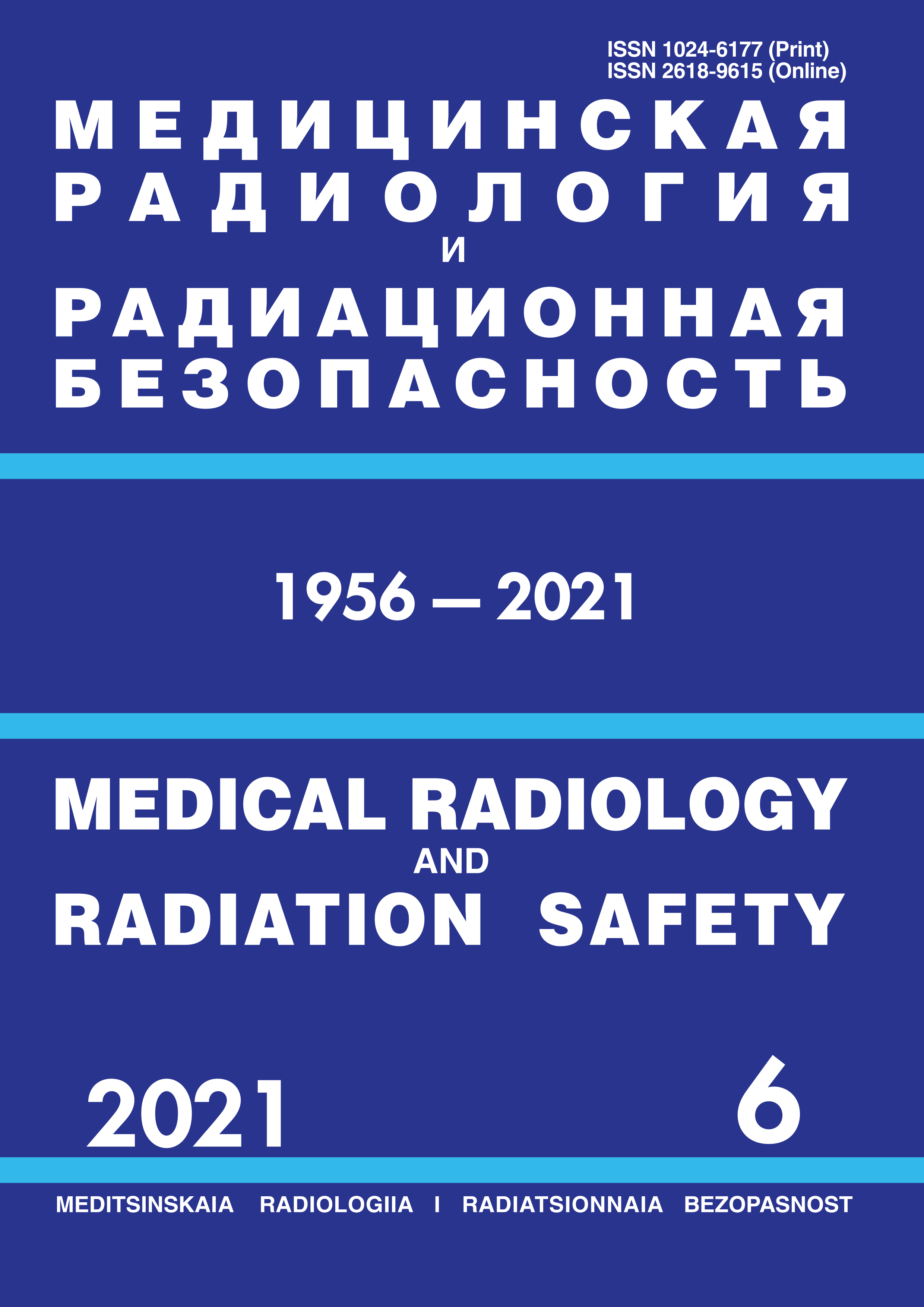Russian Federation
Russian Federation
Russian Federation
Russian Federation
Russian Federation
Russian Federation
CSCSTI 76.33
CSCSTI 76.03
Russian Classification of Professions by Education 31.06.2001
Russian Classification of Professions by Education 31.08.08
Russian Classification of Professions by Education 32.08.12
Russian Classification of Professions by Education 14.04.02
Russian Library and Bibliographic Classification 534
Russian Library and Bibliographic Classification 51
Russian Trade and Bibliographic Classification 5712
Russian Trade and Bibliographic Classification 5734
Russian Trade and Bibliographic Classification 6212
Russian Trade and Bibliographic Classification 5708
Purpose: In an article prepared on the basis of the conclusion of the Russian Scientific Commission on Radiological Protection (RSCRP) at the Department of Medical Sciences of the Russian Academy of Sciences "Assessment of the radiological consequences of the Chernobyl accident after 35 years according to the National Radiation and Epidemiological Register" (NRER), the main conclusions of the large-scale radiation-epidemiological studies carried out. Material and methods: The work uses information NRER – liquidators of the consequences of the Chernobyl accident and the Branch Register of FMBA of Russia – liquidators. When assessing the excess relative risk of malignant neoplasms, the EPICURE. Results: The current status of the National Radiation and Epidemiological Register, which is currently functioning within the framework of the Law of the Russian Federation of 30.12.2012 No. 329-FZ “On Amendments to Certain Legislative Acts of the Russian Federation in terms of ensuring that changes in the health status of certain categories of citizens are taken into account exposed to radiation". For the first time in an integral form, the article presents the medical radiological consequences of the accident at the Chernobyl nuclear power plant for the population of Russia. It was found that an increase in the incidence of thyroid cancer due to incorporated exposure to 131I was found in a cohort of children and adolescents (28 856 people) who received radiation doses of more than 200 mGy in 1986. There was no increase in the incidence of thyroid cancer among the adult population. Analysis of the incidence of solid cancers in the territories of the Bryansk, Kaluga, Tula and Oryol regions contaminated with radionuclides did not reveal an increase in the frequency of this pathology for children and adults. It is shown that in the cohort of liquidators of the Chernobyl accident, who received radiation doses of more than 150 mGy (35 303 people), an increase in the incidence of leukemia during the first 11 years after the accident at the Chernobyl nuclear power plant and solid cancers was revealed in comparison with the spontaneous level. Conclusions: The article points out serious limitations associated with a high degree of uncertainty in the received personal dosimetric data on liquidators in 1986–1987. and the need to use the total dose from all types of radiation (professional, emergency, medical, natural) to calculate the radiation risk. RSCRP emphasizes the high urgency of continuing work on reducing the uncertainty of dosimetry data and assessing the radiological consequences of the Chernobyl accident based on a comprehensive analysis of the NRER data.
Russian Scientific Commission on Radiological Protection, National Radiation and Epidemiological Register, Chernobyl Accident, medical radiological consequences, RADRUE technology, total radiation dose, medical and social rehabilitation
1. O vnesenii izmeneniy v otdel'nye zakonodatel'nye akty Rossiyskoy Federacii v chasti obespecheniya ucheta izmeneniy sostoyaniya zdorov'ya otdel'nyh kategoriy grazhdan, podvergshihsya radiacionnomu vozdeystviyu: Federal'nyy zakon ot 30.12.2012 g. № 329-FZ. https://www.consultant.ru.
2. 35 let chernobyl'skoy avarii. Itogi i perspektivy preodoleniya ee posledstviy v Rossii. 1986-2021: Rossiyskiy nacional'nyy doklad / Pod red. Bol'shova. L.A. M.: Akadem-Print, 2021. 104 s.
3. Ivanov V.K., Maksyutov M.A., Tumanov K.A. i dr. 35-letniy opyt funkcionirovaniya NRER kak gosudarstvennoy informacionnoy sistemy monitoringa radiologicheskih posledstviy chernobyl'skoy katastrofy // Radiaciya i risk. 2021. T.30, № 1. S. 7-39.
4. Ivanov V.K., Kascheev V.V., Chekin S.Yu., Maksyutov M.A. i dr. Ocenka radiacionnyh riskov zlokachestvennyh novoobrazovaniy sredi naseleniya regionov Rossii, zagryaznennyh radionuklidami vsledstvie avarii na Chernobyl'skoy AES // Radiaciya i risk. 2021. T.30, № 1. S. 131-146.
5. Kryuchkov V.P. Radiacionno-dozimetricheskie aspekty likvidacii posledstviy avarii na Chernobyl'skoy AES. M.: IzdAT, 2011, 252 s.
6. Il'in L.A., Kryuchkov V.P., Osanov D.P., Pavlov D.A. Urovni oblucheniya uchastnikov likvidacii posledstviy Chernobyl'skoy avarii v 1986-1987 gg. i verifikaciya dozimetricheskih dannyh. //Radiacionnaya biologiya. Radioekologiya 1995. T.35, № 6. S. 803-828.
7. Il'ichev S.V., Kochetkov O.A., Kryuchkov V.P., Mazurik V.K., Nosovskiy A.V., Pavlov D.A. i dr. Retrospektivnaya dozimetriya uchastnikov likvidacii posledstviy avarii na Chernobyl'skoy AES / Pod red. Kryuchkova V.P., Nosovskogo A.V. Kiev: Seda-Stil', 1996. 234 c.
8. Normy radiacionnoy bezopasnosti (NRB-99): Gigienicheskie normativy. M.: Centr sanitarno-epidemiologicheskogo normirovaniya, gigienicheskoy sertifikacii i ekspertizy Minzdrava Rossii. 1999. 116 s.
9. O radiacionnoy bezopasnosti naseleniya: Federal'nyy zakon ot 9 yanvarya 1996 g. N 3-FZ. http://base.garant.ru/10108778/.
10. Il'in L.A. Realii i mify Chernobylya. M.: ALARA Limited. 1994, 448 s.
11. Il'in L.A. Realii i mify Chernobylya. Izd. 2-e. M.: ALARA Limited. 1996. 494 s.
12. Tukov A.R., Shafranskiy I.L., Biryukov A.P., Fomin A.A. i dr. Sravnitel'nyy analiz riska pri radiacionno-epidemiologicheskom issledovanii lic, prinimavshih uchastie v likvidacii posledstviy avarii na ChAES, s ispol'zovaniem razlichnyh vidov oblucheniya // Med. radiol. i radiac. bezopasnost'. 2015. T.60, № 6. S. 27-33.
13. Tukov A.R., Biryukov A.P., Shafranskiy I.L. Bezopasna li radiacionnaya bezopasnost'? // Radiaciya i risk. 2018. T.27, № 2. S. 7-19.
14. Tukov A.R., Biryukov A.P., Shafranskiy I.L., Prohorova O.N. Ocenka radiacionnoy bezopasnosti trebuet korrektnyh epidemiologicheskih dannyh. // Yadernaya i radiacionnaya bezopasnost'. 2019. № 4. S. 22-28.





